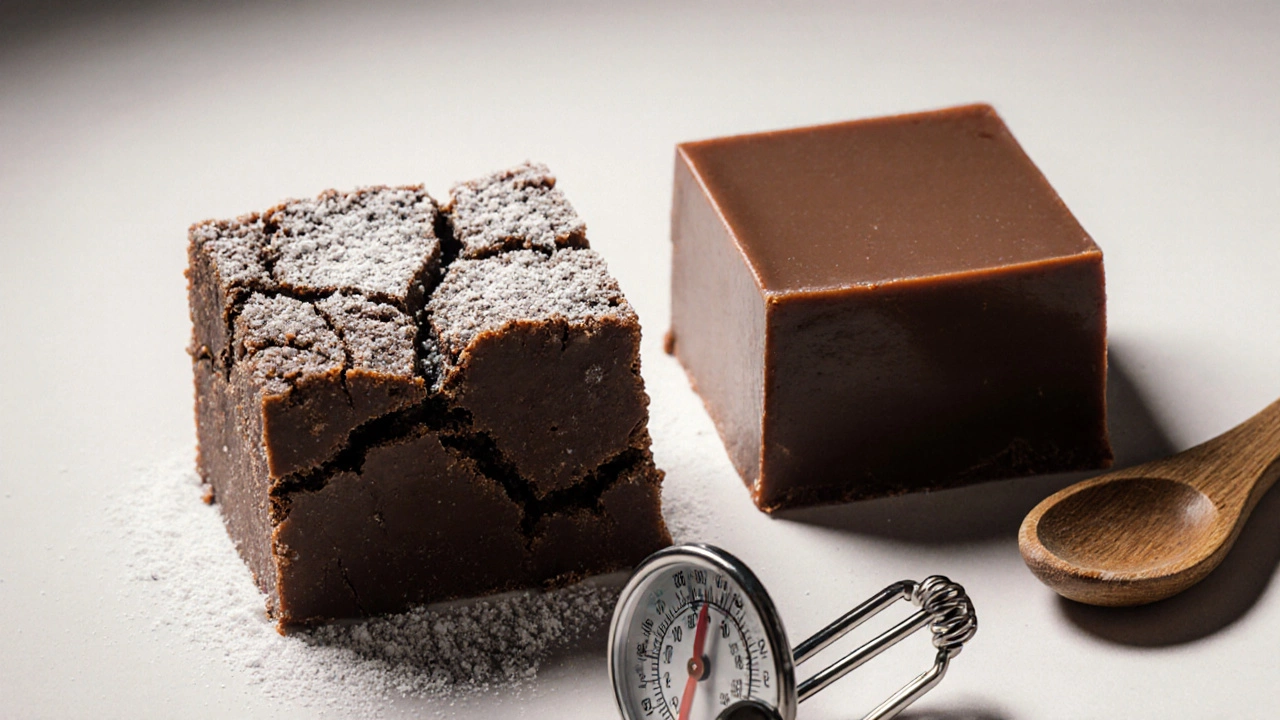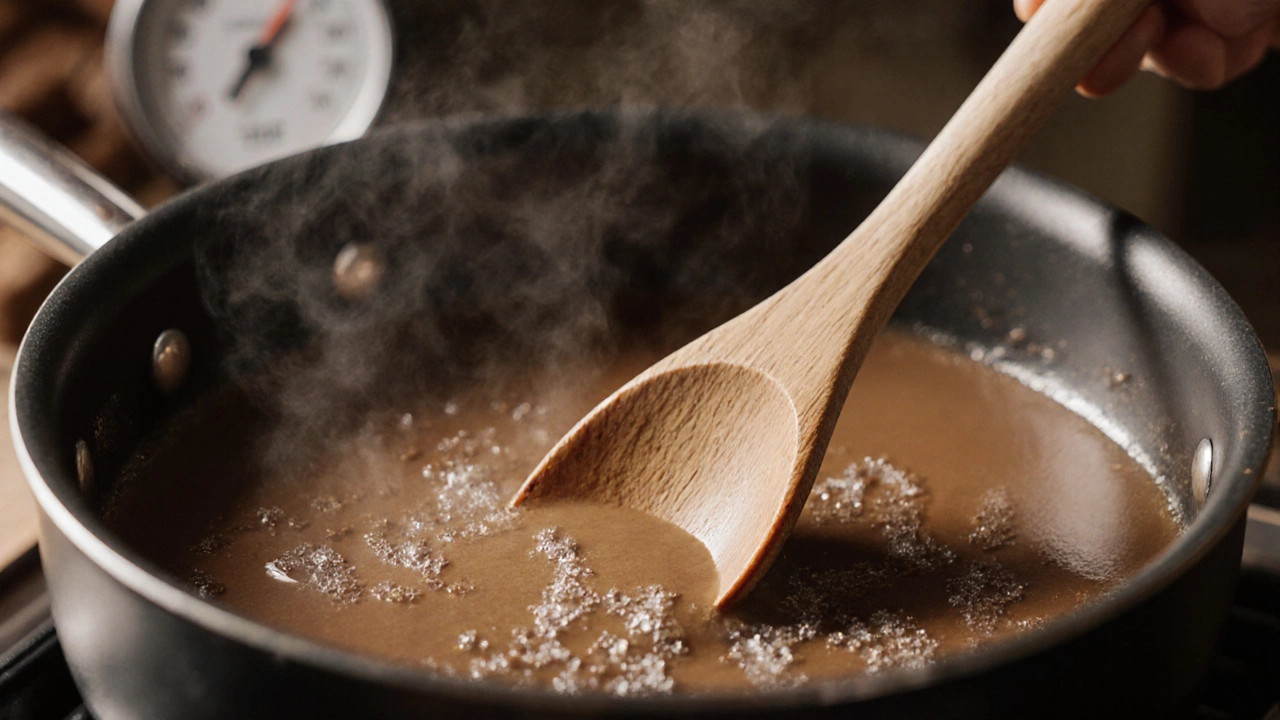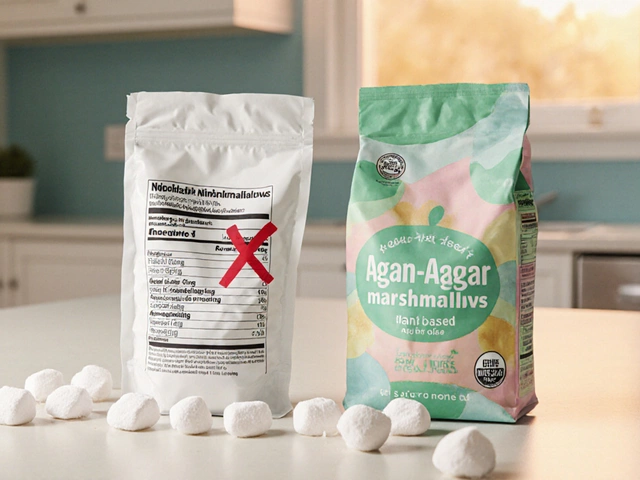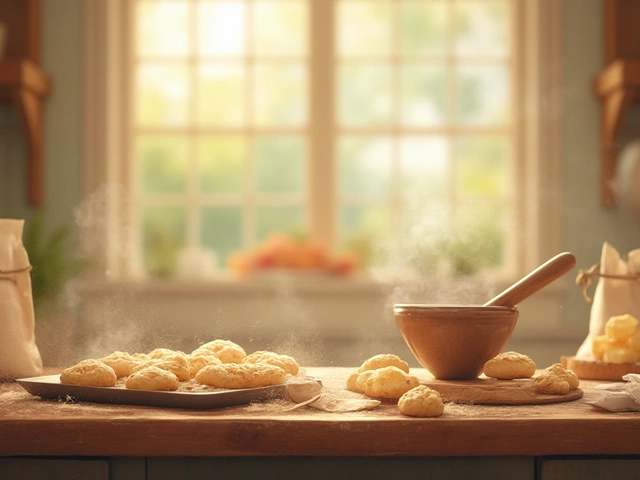Fudge Cooling Time Calculator
Perfect Fudge Temperature Guide
Wait until fudge reaches 110°F (43°C) before stirring
Enter the current temperature to see when to start stirring.
Ever made fudge, walked away for a few minutes, and came back to find it grainy, crumbly, or worse-rock hard? You didn’t ruin it by accident. You just skipped the most important step: stirring. Not stirring fudge at the right time doesn’t just change the texture-it completely transforms what you’re eating from smooth, melt-in-your-mouth candy into something that feels like crushed sugar crystals glued together.
Why stirring matters more than you think
Fudge isn’t just melted chocolate and sugar. It’s a controlled crystal formation. When you heat sugar, butter, and milk to 234°F (112°C), you’re making a supersaturated sugar solution. That means there’s more sugar dissolved in the liquid than should normally fit. At that point, the mixture is unstable. It’s waiting for a trigger to turn into solid sugar crystals. That trigger? Cooling. And how you cool it determines the size of those crystals. If you stir too early-while the mixture is still hot-you force sugar molecules to latch onto each other and form big, rough crystals. That’s why some people say to wait until the fudge cools before stirring. But if you don’t stir at all after cooling? You get uneven crystallization. Some parts harden fast. Others stay sticky. The result? A mess that’s gritty in spots and chewy in others.What actually happens when you skip the stir
Let’s say you follow the recipe perfectly: you bring the mixture to a boil, cook it to the soft-ball stage, then take it off the heat. You think, “I’ll let it cool on its own.” You walk away. You check back in an hour. The surface is dull and cracked. You scrape a spoon in-and it breaks like chalk. Here’s why:- Large crystals form randomly. Without stirring, sugar molecules cluster where they happen to be. Some areas get too many molecules stuck together. That’s where you get hard, crunchy bits.
- Oil separates. Butter and cream in fudge are emulsified by agitation. No stirring means the fat rises to the top, leaving a greasy film and dry, powdery chunks underneath.
- Temperature gradients create uneven texture. The bottom of the pan cools faster than the top. Without stirring to even it out, the bottom sets first and becomes dense and brittle. The top stays soft and sticky.
- It doesn’t hold its shape. Properly stirred fudge holds a clean edge when cut. Unstirred fudge crumbles, smears, or pulls apart like wet sand.
There’s a reason every fudge recipe says: “Let cool to 110°F, then stir constantly for 5 to 10 minutes.” That’s not a suggestion. It’s the only way to force millions of tiny crystals to form all at once. Tiny crystals = smooth texture. Big crystals = gritty disaster.
The science of crystal control
Think of sugar like people in a crowded room. If everyone starts dancing randomly, you get chaos. But if you tell them all to start moving in sync, you get a smooth line. Stirring fudge is like directing that dance. When you stir cooled fudge, you’re introducing thousands of tiny seed crystals. These become the foundation for every other sugar molecule to attach to. Because they’re all forming around the same starting points, they stay small and uniform. No stirring? No direction. Sugar molecules find their own partners. Some latch on early and grow big. Others wait too long and get left out. The result? A texture that’s inconsistent, unpleasant, and hard to eat. In professional candy kitchens, they use temperature-controlled cooling tables and mechanical stirrers. At home? You use a wooden spoon and patience. But the principle is the same: control the crystal growth.
How to fix it if you forgot to stir
You made fudge. You didn’t stir. It’s already hard. Can you save it? Yes-but only if you act fast. If it’s been less than 30 minutes since you took it off the heat and it’s still warm but starting to set:- Put the pan back on low heat.
- Add 2 tablespoons of heavy cream or evaporated milk.
- Stir gently until everything melts again.
- Bring it back to 234°F (112°C), then remove from heat.
- Let it cool to 110°F again, then stir for 10 minutes until it thickens and loses its shine.
If it’s been hours and it’s rock solid? You’re better off repurposing it. Crumble it over ice cream. Melt it into brownie batter. Use it as a topping for oatmeal. It won’t be fudge anymore-but it’ll still taste sweet.
What to do instead: the right way to stir fudge
Here’s the foolproof method, tested in Halifax kitchens and tested again in home test kitchens across Canada:- Use a wooden spoon. Metal conducts heat too fast and can cause uneven cooling.
- Wait until the mixture reaches 110°F (43°C). Use a candy thermometer. Don’t guess.
- Stir slowly, steadily, and constantly. Don’t scrape the sides-just move the spoon in figure-eights across the bottom.
- Keep stirring until it thickens and loses its glossy sheen. That usually takes 5 to 10 minutes.
- Pour into a greased pan immediately. Don’t wait. The moment it loses shine, it’s ready to set.
Pro tip: If your kitchen is cold, the fudge will cool faster. In Halifax winters, you might need to stir for 12 minutes. In summer? Maybe only 6. Watch the texture, not the clock.

Common mistakes people make (and how to avoid them)
- Mistake: Stirring while it’s still hot. Fix: Wait until it’s cool enough to touch the side of the bowl without burning.
- Mistake: Using a whisk. Fix: Whisks incorporate air and make fudge airy and grainy. Stick to a wooden spoon.
- Mistake: Rushing the cooling. Fix: Don’t put it in the fridge to speed things up. That causes sugar bloom and a chalky surface.
- Mistake: Not greasing the pan. Fix: Use butter or non-stick spray. Fudge sticks like glue if the pan isn’t prepared.
One last thing: if your fudge turns out grainy even after stirring? Your sugar wasn’t fully dissolved at the start. Make sure to stir the sugar, butter, and milk over low heat until the sugar disappears before bringing it to a boil. That’s the real secret.
Why fudge is different from other candies
Caramel? You stir it the whole time. Hard candy? You don’t stir at all. But fudge sits in the middle. It needs both control and chaos. That’s why it’s so tricky. Too much stirring, and you get a sugar paste. Too little, and you get a sugar rock. The magic is in the timing. That’s also why so many people give up on fudge. It’s not about ingredients. It’s about rhythm. It’s about watching, waiting, and then moving when the moment is right.Final takeaway
Not stirring fudge doesn’t mean you failed. It just means you missed the moment when science turned sugar into something magical. Stirring isn’t optional. It’s the bridge between a sweet mess and a perfect square of chocolatey bliss.Next time you make fudge, set a timer for 10 minutes after it cools. Don’t walk away. Don’t check your phone. Stir. Just stir. And watch how something simple becomes extraordinary.
What happens if you stir fudge too early?
Stirring fudge while it’s still hot (above 110°F) causes large sugar crystals to form, making it grainy and tough. The mixture needs to cool first so that tiny, even crystals can develop during stirring.
Can you fix fudge that didn’t get stirred?
Yes, if it’s still warm. Reheat it gently with a little cream, bring it back to 234°F, then let it cool again and stir properly. If it’s fully hardened, repurpose it as a topping or mix-in-it won’t be smooth fudge, but it’ll still taste good.
Why does fudge need to be stirred for so long?
Stirring for 5-10 minutes after cooling forces thousands of tiny sugar crystals to form simultaneously. This creates a smooth, creamy texture. Without enough stirring, crystals form unevenly, leading to grittiness.
Is a wooden spoon better than a metal spoon for fudge?
Yes. Wooden spoons don’t conduct heat as quickly, so they help maintain an even temperature while stirring. Metal spoons can cause the mixture to cool unevenly and may even scrape off bits of hardened sugar from the pan.
Why does my fudge turn out dry or crumbly?
Dry or crumbly fudge usually means it was overcooked (too high a temperature) or not stirred enough after cooling. Both lead to large sugar crystals and poor fat distribution. Always use a candy thermometer and stir until the gloss disappears.
Should I refrigerate fudge to make it set faster?
No. Refrigerating fudge causes sugar bloom-a white, powdery surface-and can make it overly firm or crumbly. Let it set at room temperature for the best texture and flavor.





